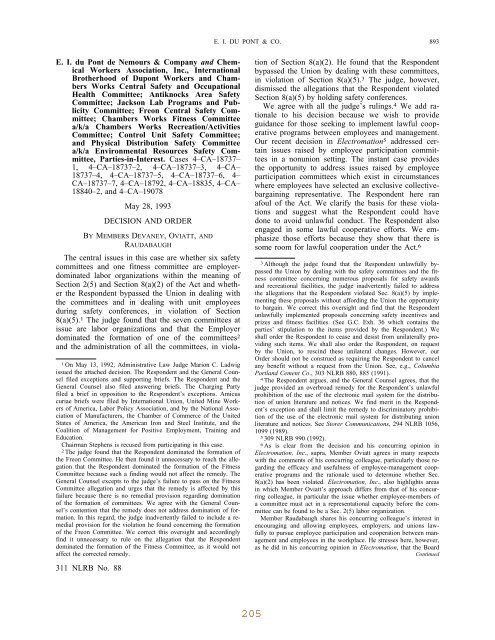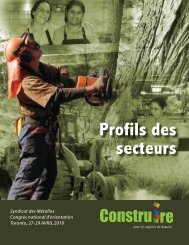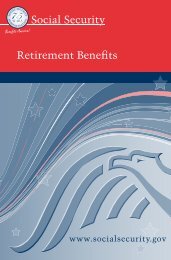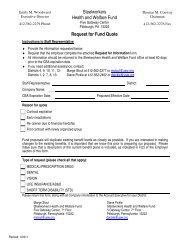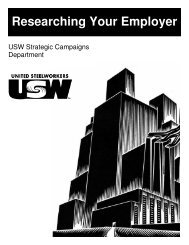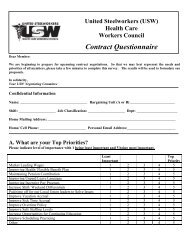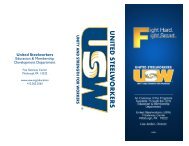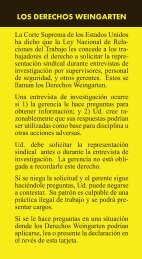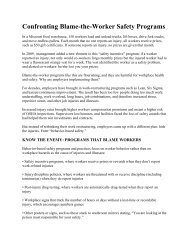Union Approach to Health and Safety: - United Steelworkers
Union Approach to Health and Safety: - United Steelworkers
Union Approach to Health and Safety: - United Steelworkers
You also want an ePaper? Increase the reach of your titles
YUMPU automatically turns print PDFs into web optimized ePapers that Google loves.
E. I. DU PONT & CO.<br />
893<br />
E. I. du Pont de Nemours & Company <strong>and</strong> Chemical<br />
Workers Association, Inc., International<br />
Brotherhood of Dupont Workers <strong>and</strong> Chambers<br />
Works Central <strong>Safety</strong> <strong>and</strong> Occupational<br />
<strong>Health</strong> Committee; Antiknocks Area <strong>Safety</strong><br />
Committee; Jackson Lab Programs <strong>and</strong> Publicity<br />
Committee; Freon Central <strong>Safety</strong> Committee;<br />
Chambers Works Fitness Committee<br />
a/k/a Chambers Works Recreation/Activities<br />
Committee; Control Unit <strong>Safety</strong> Committee;<br />
<strong>and</strong> Physical Distribution <strong>Safety</strong> Committee<br />
a/k/a Environmental Resources <strong>Safety</strong> Committee,<br />
Parties-in-Interest. Cases 4–CA–18737–<br />
1, 4–CA–18737–2, 4–CA–18737–3, 4–CA–<br />
18737–4, 4–CA–18737–5, 4–CA–18737–6, 4–<br />
CA–18737–7, 4–CA–18792, 4–CA–18835, 4–CA–<br />
18840–2, <strong>and</strong> 4–CA–19078<br />
1 On May 13, 1992, Administrative Law Judge Marion C. Ladwig<br />
issued the attached decision. The Respondent <strong>and</strong> the General Counsel<br />
filed exceptions <strong>and</strong> supporting briefs. The Respondent <strong>and</strong> the<br />
General Counsel also filed answering briefs. The Charging Party<br />
filed a brief in opposition <strong>to</strong> the Respondent’s exceptions. Amicus<br />
curiae briefs were filed by International <strong>Union</strong>, <strong>United</strong> Mine Workers<br />
of America, Labor Policy Association, <strong>and</strong> by the National Association<br />
of Manufacturers, the Chamber of Commerce of the <strong>United</strong><br />
States of America, the American Iron <strong>and</strong> Steel Institute, <strong>and</strong> the<br />
Coalition of Management for Positive Employment, Training <strong>and</strong><br />
Education.<br />
Chairman Stephens is recused from participating in this case.<br />
2 The judge found that the Respondent dominated the formation of<br />
the Freon Committee. He then found it unnecessary <strong>to</strong> reach the allegation<br />
that the Respondent dominated the formation of the Fitness<br />
Committee because such a finding would not affect the remedy. The<br />
General Counsel excepts <strong>to</strong> the judge’s failure <strong>to</strong> pass on the Fitness<br />
Committee allegation <strong>and</strong> urges that the remedy is affected by this<br />
failure because there is no remedial provision regarding domination<br />
of the formation of committees. We agree with the General Counsel’s<br />
contention that the remedy does not address domination of formation.<br />
In this regard, the judge inadvertently failed <strong>to</strong> include a remedial<br />
provision for the violation he found concerning the formation<br />
of the Freon Committee. We correct this oversight <strong>and</strong> accordingly<br />
find it unnecessary <strong>to</strong> rule on the allegation that the Respondent<br />
dominated the formation of the Fitness Committee, as it would not<br />
affect the corrected remedy.<br />
311 NLRB No. 88<br />
May 28, 1993<br />
DECISION AND ORDER<br />
BY MEMBERS DEVANEY, OVIATT, AND<br />
RAUDABAUGH<br />
The central issues in this case are whether six safety<br />
committees <strong>and</strong> one fitness committee are employerdominated<br />
labor organizations within the meaning of<br />
Section 2(5) <strong>and</strong> Section 8(a)(2) of the Act <strong>and</strong> whether<br />
the Respondent bypassed the <strong>Union</strong> in dealing with<br />
the committees <strong>and</strong> in dealing with unit employees<br />
during safety conferences, in violation of Section<br />
8(a)(5). 1 The judge found that the seven committees at<br />
issue are labor organizations <strong>and</strong> that the Employer<br />
dominated the formation of one of the committees 2<br />
<strong>and</strong> the administration of all the committees, in violation<br />
of Section 8(a)(2). He found that the Respondent<br />
bypassed the <strong>Union</strong> by dealing with these committees,<br />
in violation of Section 8(a)(5). 3 The judge, however,<br />
dismissed the allegations that the Respondent violated<br />
Section 8(a)(5) by holding safety conferences.<br />
We agree with all the judge’s rulings. 4 We add rationale<br />
<strong>to</strong> his decision because we wish <strong>to</strong> provide<br />
guidance for those seeking <strong>to</strong> implement lawful cooperative<br />
programs between employees <strong>and</strong> management.<br />
Our recent decision in Electromation 5 addressed certain<br />
issues raised by employee participation committees<br />
in a nonunion setting. The instant case provides<br />
the opportunity <strong>to</strong> address issues raised by employee<br />
participation committees which exist in circumstances<br />
where employees have selected an exclusive collectivebargaining<br />
representative. The Respondent here ran<br />
afoul of the Act. We clarify the basis for these violations<br />
<strong>and</strong> suggest what the Respondent could have<br />
done <strong>to</strong> avoid unlawful conduct. The Respondent also<br />
engaged in some lawful cooperative efforts. We emphasize<br />
those efforts because they show that there is<br />
some room for lawful cooperation under the Act. 6<br />
3 Although the judge found that the Respondent unlawfully bypassed<br />
the <strong>Union</strong> by dealing with the safety committees <strong>and</strong> the fitness<br />
committee concerning numerous proposals for safety awards<br />
<strong>and</strong> recreational facilities, the judge inadvertently failed <strong>to</strong> address<br />
the allegations that the Respondent violated Sec. 8(a)(5) by implementing<br />
these proposals without affording the <strong>Union</strong> the opportunity<br />
<strong>to</strong> bargain. We correct this oversight <strong>and</strong> find that the Respondent<br />
unlawfully implemented proposals concerning safety incentives <strong>and</strong><br />
prizes <strong>and</strong> fitness facilities. (See G.C. Exh. 36 which contains the<br />
parties’ stipulation <strong>to</strong> the items provided by the Respondent.) We<br />
shall order the Respondent <strong>to</strong> cease <strong>and</strong> desist from unilaterally providing<br />
such items. We shall also order the Respondent, on request<br />
by the <strong>Union</strong>, <strong>to</strong> rescind these unilateral changes. However, our<br />
Order should not be construed as requiring the Respondent <strong>to</strong> cancel<br />
any benefit without a request from the <strong>Union</strong>. See, e.g., Columbia<br />
Portl<strong>and</strong> Cement Co., 303 NLRB 880, 885 (1991).<br />
4 The Respondent argues, <strong>and</strong> the General Counsel agrees, that the<br />
judge provided an overbroad remedy for the Respondent’s unlawful<br />
prohibition of the use of the electronic mail system for the distribution<br />
of union literature <strong>and</strong> notices. We find merit in the Respondent’s<br />
exception <strong>and</strong> shall limit the remedy <strong>to</strong> discrimina<strong>to</strong>ry prohibition<br />
of the use of the electronic mail system for distributing union<br />
literature <strong>and</strong> notices. See S<strong>to</strong>rer Communications, 294 NLRB 1056,<br />
1099 (1989).<br />
5 309 NLRB 990 (1992).<br />
6 As is clear from the decision <strong>and</strong> his concurring opinion in<br />
Electromation, Inc., supra, Member Oviatt agrees in many respects<br />
with the comments of his concurring colleague, particularly those regarding<br />
the efficacy <strong>and</strong> usefulness of employee-management cooperative<br />
programs <strong>and</strong> the rationale used <strong>to</strong> determine whether Sec.<br />
8(a)(2) has been violated. Electromation, Inc., also highlights areas<br />
in which Member Oviatt’s approach differs from that of his concurring<br />
colleague, in particular the issue whether employee-members of<br />
a committee must act in a representational capacity before the committee<br />
can be found <strong>to</strong> be a Sec. 2(5) labor organization.<br />
Member Raudabaugh shares his concurring colleague’s interest in<br />
encouraging <strong>and</strong> allowing employees, employers, <strong>and</strong> unions lawfully<br />
<strong>to</strong> pursue employee participation <strong>and</strong> cooperation between management<br />
<strong>and</strong> employees in the workplace. He stresses here, however,<br />
as he did in his concurring opinion in Electromation, that the Board<br />
Continued


